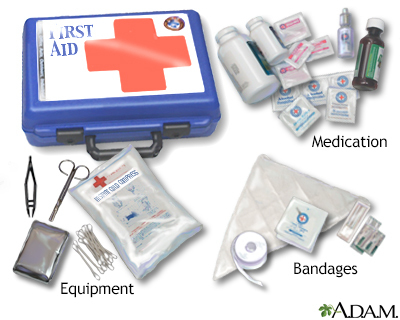First aid kit
Information
You should make sure that you and your family are prepared to treat common symptoms, injuries, and emergencies. By planning ahead, you can create a well-stocked home first aid kit. Keep all of your supplies in one location so you know exactly where they are when you need them.
The following items are basic supplies. You can get most of them at a pharmacy or supermarket.
Bandages and dressings:
- Adhesive bandages (Band-Aid or similar brand); assorted sizes
- Aluminum finger splints
- Elastic (ACE) bandage for wrapping wrist, ankle, knee, and elbow injuries
- Eye shield, pads, and bandages
- Latex or non-latex gloves to reduce contamination risk
- Sterile gauze pads, non-stick (Adaptic-type, petrolatum or other) gauze and adhesive tape
- Triangular bandage for wrapping injuries and making an arm sling
Home health equipment:
- Blue baby bulb or turkey baster suction device
- Disposable, instant ice bags
- Face mask to reduce wound contamination risk
- First-aid manual
- Hand sanitizer
- Latex or non-latex gloves to reduce contamination risk
- Save-A-Tooth storage device in case a tooth is broken or knocked out; contains a travel case and salt solution
- Sterile cotton balls
- Sterile cotton-tipped swabs
- Syringe, medicine cup, or medicine spoon for giving specific doses of medicine
- Thermometer
- Tweezers, to remove ticks and small splinters
Medicine for cuts and injuries:
- Antiseptic solution or wipes, such as hydrogen peroxide, povidone-iodine, or chlorhexidine
- Antibiotic ointment, such as bacitracin, polysporin, or mupirocin
- Sterile eyewash, such as contact lens saline solution
- Calamine lotion for stings or poison ivy
- Hydrocortisone cream, ointment, or lotion for itching
Be sure to check your kit regularly. Replace any supplies that are getting low or have expired.
Other supplies may be included in a first aid kit. This depends on the area in which you plan to spend time.
Gallery

References
American Academy of Family Physicians website. What do I need in my first aid kit? familydoctor.org/what-do-i-need-in-my-first-aid-kit. Updated June 7, 2017. Accessed April 22, 2021.
American College of Emergency Physicians website. First Aid Kit. www.emergencyphysicians.org/article/health--safety-tips/first-aid-kit. Accessed January 11, 2023.
Auerbach PS. First-aid kits. In: Auerbach PS, ed. Medicine for the Outdoors: The Essential Guide to First-Aid and Medical Emergencies. 6th ed. Philadelphia, PA: Elsevier; 2016:415-420.